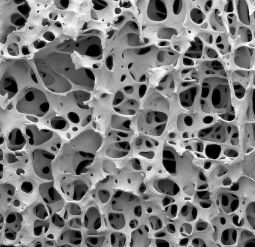This study aims at investigating the co-implantation of human adipose-derived stem cells (ADSCs) after osteogenic differentiation and human umbilical vein endothelial cells (HUVECs) embedded in a vascularized osteogenic matrix of hydroxyapatite (HAp) ceramic for bone tissue engineering. Interestingly, the implantation of HUVEC led to bone formation, suggesting that implanted HUVEC stimulated bone formation. This result may be caused the ability of the extracellular matrix from HUVEC to stimulate the osteogenic differentiation of osteoprogenitor cells. The implantation of osteogenically differentiated ADSC led to higher bone formation than the implantation of HUVEC. But only the co-implantation of ADSC and HUVEC led to a statistically significant larger bone area compared to the other cell-containing groups. This supports the results of earlier studies which showed that endothelial cells stimulate proliferation, cell survival and osteogenic differentiation of osteoprogenitor cells in vitro and bone formation in vivo. Hence, the co-implantation of differentiated ADSCs with HUVECs may therefore be considered as a promising approach for bone tissue engineering. As the specialist in the production of endothelial cells, Abcell-bio is your partner to enable your research.
Human Umbilical Vein Endothelial Cell Support Bone Formation of Adipose-Derived Stem Cell

Julie Vendomele
Scientific Project Manager
After a bachelor's degree in biology, Julie integrates a master in Immunology at the Pierre et Marie Curie University in Paris. Then she joined Genethon laboratory, where she passes her PhD in Immunology in 2018. After an experience as a site manager in a private school, she joins Abcell-bio as Sales Manager. In 2021, she evolved as our scientific project manager, to manage R&D projects. She also provides scientific advice to customers.

